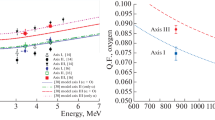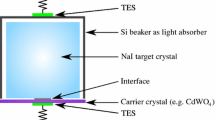Abstract
Anisotropic scintillators can offer a unique possibility to exploit the so-called directionality approach in order to investigate the presence of those Dark Matter (DM) candidates inducing nuclear recoils. In fact, their use can overcome the difficulty of detecting extremely short nuclear recoil traces. In this paper we present recent measurements performed on the anisotropic response of a \(\hbox {ZnWO}_4\) crystal scintillator to nuclear recoils, in the framework of the ADAMO project. The anisotropic features of the \(\hbox {ZnWO}_4\) crystal scintillators were initially measured with \(\alpha \) particles; those results have been also confirmed by the additional measurements presented here. The experimental nuclear recoil data were obtained by using a neutron generator at ENEA-CASACCIA and neutron detectors to tag the scattered neutrons; in particular, the quenching factor values for nuclear recoils along different crystallographic axes have been determined for three different neutron scattering angles (i.e. nuclear recoils energies). From these measurements, the anisotropy of the light response for nuclear recoils in the \(\hbox {ZnWO}_4\) crystal scintillator has been determined at 5.4 standard deviations.












Similar content being viewed by others
Data Availability Statement
This manuscript has no associated data or the data will not be deposited. [Authors’ comment: All the data generated during this study are contained in this published article.]
Notes
The etching procedure was applied to remove possible surface radioactive contamination of 3 samples of \(\hbox {ZnWO}_4\) scintillators, including the one used in the present study. Two other samples of larger mass, produced from the same crystal boule, were installed in a low-background set-up to investigate radioactive contamination of the material. The measurements are similar to those described in Ref. [15].
The quenching factor Q.F. describes the response of a scintillator to heavy ionizing particles; in details, it is the ratio between the detected energy in the energy scale measured with \(\gamma \) sources to the energy of the heavy ionizing particle.
Many times it is also named \(\alpha /\beta \) ratio.
The typical live time for each data set ranges from 11 to 25 h depending on the scattering angle and crystal axis.
References
R. Bernabei et al., Riv. Nuovo Cim. 26(1), 1 (2003)
R. Bernabei et al., Eur. Phys. J. C 56, 333 (2008)
R. Bernabei et al., Eur. Phys. J. C 67, 39 (2010)
R. Bernabei et al., Eur. Phys. J. C 73, 2648 (2013)
R. Bernabei et al., Nucl. Phys. At. Energy 19, 307 (2018)
R. Bernabei et al., Nucl. Phys. At. Energy 20, 317 (2019)
D.N. Spergel, Phys. Rev. D 37, 1353 (1988)
P. Belli et al., Nuovo Cim. C 15, 475 (1992)
R. Bernabei et al., Eur. Phys. J. C 28, 203 (2003)
F. Cappella et al., Eur. Phys. J. C 73, 2276 (2013)
F.A. Danevich et al., Nucl. Instrum. Methods A 544, 553 (2005)
P. Belli et al., Nucl. Instrum. Methods A 626–627, 31 (2011)
P. Belli et al., J. Phys. G 38, 115107 (2011)
A.S. Barabash et al., Nucl. Instrum. Methods A 833, 77 (2016)
P. Belli et al., Nucl. Instrum. Methods A 935, 89 (2019)
J.B. Birks, The Theory and Practice of Scintillation Counting (Pergamon, London, 1964)
P.H. Heckmann, Z. Phys. 157, 10 (1959)
P.H. Heckmann et al., Z. Phys. 162, 84 (1961)
W.F. Kienzle, A. Flammersfeld, Z. Phys. 165, 1 (1961)
K. Tsukada, S. Kikuchi, Nucl. Instrum. Methods 17, 286 (1962)
K. Tsukada et al., Nucl. Instrum. Methods 37, 69 (1965)
F.J. Kratochwill, Z. Phys. 234, 74 (1970)
F.D. Brooks, D.T. Jones, Nucl. Instrum. Methods 121, 69 (1974)
V. Caracciolo et al., J. Phys. Conf. Ser. 718, 042011 (2016)
R. Cerulli for DAMA/INR-Kyiv collaboration, talk at IPRD 2019, 14–17 October 2019, Siena, Italy. http://people.roma2.infn.it/dama/pdf/cerulli_IPRD2019.pdf
A. Di Marco for DAMA/INR-Kyiv collaboration, talk at CYGNUS 2019 workshop on directional DM detection, 10–12 July 2019, Rome, Italy. http://people.roma2.infn.it/dama/pdf/cygnus_2019.pdf
V. Caracciolo for DAMA/INR-Kyiv collaboration, Particle Physics at the Silver Jubilee of Lomonosov Conferences, p. 464 (2019)
R. Bernabei et al., EPJ Web Conf. 136, 05002 (2017)
V. Caracciolo for DAMA/INR-Kyiv collaboration, talk at CYGNUS-TPC kick-off meeting: a mini-workshop on directional Dark Matter searches and coherent neutrino scattering, LNF, 7 April 2016, Italy
R. Bernabei et al., AIP Conf. Proc. 1549, 189 (2013)
V.N. Shlegel et al., JINST 12, C08011 (2017)
V.I. Tretyak, Astropart. Phys. 33, 40 (2010)
Scionix high flash-point EJ-309 liquid scintillation detectors. https://scionix.nl/wp-content/uploads/2017/07/High-flashpoint-EJ-309-liquid-scintillation-detectors.pdf
Datasheet for ET Enterprises 9821. http://et-enterprises.com/images/ data_sheets/9821B.pdf
Datasheet for Hamamatsu H11934-200. https://www.hamamatsu.com/ resources/pdf/etd/R11265U_H11934_TPMH1336E.pdf
P.G. Bizzeti et al., Nucl. Instrum. Methods A 696, 144 (2012)
Acknowledgements
It is a pleasure to thank Mr. A. Bussolotti and Mr. A. Mattei for their valuable technical support and Dr. M. Laubenstein for providing the silicon detector and for fruitful discussions. The group from the Institute for Nuclear Research was supported in part by the program of the National Academy of Sciences of Ukraine “Fundamental research on high-energy physics and nuclear physics (international cooperation)” (Grant no. 0118U005411). D.V.K. and O.G.P. were supported in part by the project “Investigations of rare nuclear processes” of the program of the National Academy of Sciences of Ukraine “Laboratory of young scientists” (Grant no. 0118U002328).
Author information
Authors and Affiliations
Corresponding author
Additional information
Communicated by Alessia Di Pietro.
Rights and permissions
About this article
Cite this article
Belli, P., Bernabei, R., Cappella, F. et al. Measurements of \(\hbox {ZnWO}_4\) anisotropic response to nuclear recoils for the ADAMO project. Eur. Phys. J. A 56, 83 (2020). https://doi.org/10.1140/epja/s10050-020-00094-z
Received:
Accepted:
Published:
DOI: https://doi.org/10.1140/epja/s10050-020-00094-z




